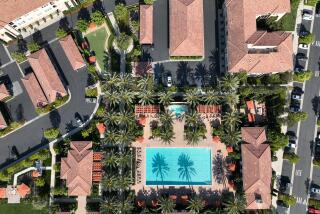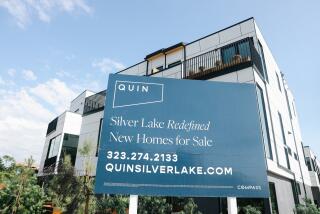Wealthy Chinese home buyers boost suburban L.A. housing markets
The overflow from China’s economic high tide is transforming the housing markets of suburban Los Angeles.
Affluent Chinese home buyers are driving prices past boom-era peaks, spawning a subset of property brokers and mortgage lenders that cater to their distinct needs — and even dictate design details in new subdivisions.
The strongest magnet is the San Gabriel Valley, where Monterey Park became known as the “first suburban Chinatown” in the 1970s. Selling real estate there now requires familiarity with feng shui, the ancient Chinese principles of harmonious design.
“People are getting money out of mainland China and sticking it here,” said Mel Wong, president of the West San Gabriel Valley Assn. of Realtors.
The trend has spilled over into other areas, including San Bernardino and Orange counties and even Las Vegas, with more acculturated Chinese Americans seeking homes big enough to host lengthy visits from overseas relatives.
Chinese buyers bought 12% of all U.S. homes purchased by foreign citizens last year, up from 5% in 2007, according to the National Assn. of Realtors. More than half their home purchases were in California. And more than two-thirds of them paid cash, the trade group said.
The trend appears unlikely to unwind soon. More than 60% of China’s wealthy have left or plan to leave the country, at least part time, and their No. 1 destination is the United States, according to the Hurun Report, a Shanghai publishing firm focused on recently minted millionaires and billionaires.
Despite dizzying ups and downs in U.S. home prices, the market can seem more stable than in China, where fears of a property bubble have added to the economic and political worries of the burgeoning middle and upper classes.
Motivations vary by location. Luxury estates in San Marino are bargains by Chinese standards; inexpensive Inland Empire homes are purchased as investments; top-shelf schools draw throngs to Irvine.
Eva Chen and her husband travel between their homes in Shanghai and Arcadia, where they purchased a property near Santa Anita Park in October. They scooped up the second home as an escape from pollution and a shot at better schools for their two infants.
Compared with housing prices in China, the $1.27-million Arcadia property didn’t seem expensive.
“The Arcadia house is cheaper,” Chen said.
But it’s getting more expensive quickly. Heavy demand pushed the median home sales price past $1.32 million last quarter in Arcadia’s 91007 ZIP Code — 30.5% above its peak in 2007, during the housing bubble, according to researcher DataQuick.
Next door in the 91006 ZIP Code, prices are up 23.7%. Other areas with prices exceeding their peaks include Walnut, Temple City, San Marino and parts of San Gabriel and East San Gabriel, all hubs for Chinese investment.
The Chinese buying spree sometimes borders on recklessness, said Dominic Ng, chairman of Pasadena’s East West Bank, the largest Chinese-American bank. East West specializes in home loans for Chinese buyers with no U.S. credit histories, but often enormous down payments.
Unwary buyers accustomed to urban China’s $1-million-plus luxury flats take “housing tours” and snap up homes east of Riverside or in Arizona without considering the cost of property taxes (China has none) or maintenance of homes with pools and yards.
“They look at the dinky little apartment in Shanghai or Beijing — you know, like one-fifth the size — and they say this is affordable,” said Ng, who fears prices will appreciate less than the buyers expect. “They are buying for speculative purposes.”
Others want the prestige of a San Marino or Pasadena mansion, even if paying for it means working in China and rarely visiting. One of Ng’s neighbors bought a Pasadena estate, then lived there for just two days out of the two years that followed.
“He was not renting it out,” Ng said. “People have so much money, they just say, ‘What the heck. It’s a nice neighborhood. I might as well just buy one.’”
It’s a story echoed by Patti Hahn of Arcadia, gesturing to the house next door, which sold for $2.45 million last year, up from $1.55 million in 2006, the last time it changed hands.
“No one lives there,” Hahn said.
The buyers pay for twice-weekly maintenance work, she said. They live overseas but plan to start splitting time between the U.S. and China this year, said Johnny Lam, the buyers’ agent.
Home builders have taken note of the surging interest from Chinese buyers, as well as Chinese Americans who have lived in the U.S. for years but still favor neighborhoods and amenities that reflect their native culture.
At Lambert Ranch — an Irvine development of $1-million-and-up homes that quickly sold out last year — Chinese benches and figurines decorated the downstairs of model homes. At one model, would-be buyers climbed stairs decorated with large photos of the Great Wall and a Chinese farmer cradling a basket of rice.
Downstairs, the New Home Co. houses were designed with separate master bedrooms and baths that sales staffers said were intended for relatives from foreign countries. The most expensive homes have detached studio apartments for visitors.
Builder Lennar Corp. took a similar strategy. It had initially created a home design in response to job losses from the recession — a small apartment, built within a house, so extended families could live together. But it has since modified the plans to accommodate the tastes of Asian families, who also often live with elder relatives.
The Lennar home that Tom and Rebecca Chow bought last year in Chino’s College Park area has not only this “home within a home” design, but also a second “wok” kitchen designed to accommodate Chinese cooking. The range has a 50,000 British thermal unit double burner for high-temperature recipes, a high-powered exhaust fan to carry off the smoke, and walls covered in white tile for easy cleanup of spatters.
The home is aligned to avoid feng shui miscues: You can’t see the back door or a staircase from the front door, both of which are thought to create imbalance. Lennar sales representative Michael Lua also noted that the sink and refrigerator in the main kitchen are not directly across from the oven and range, which would create friction between water and fire elements.
The Chows, originally from Hong Kong, came to the U.S. more than two decades ago as students and stayed. They now have a son at a university and a daughter getting ready to go. The apartment enables them to host relatives from Hong Kong, Canada and Saudi Arabia, as well as their own returning children and a college-age niece, Tom Chow said.
In Las Vegas, which has a long-established community of ethnic Chinese residents, as well as the allure of gambling and inexpensive housing, Lennar went a step further when it developed a 40-acre housing tract, Lantern Gardens, on the outskirts of town.
In addition to applying feng shui design principles and interior apartments for relatives, Lennar designed a central park that is round instead of square and aligned most of the homes on a north-south axis, reflecting the preferences of many Chinese.
“The traffic coming through was principally Asian, and mostly Chinese,” said Jeremy Parness, the company’s division president for the area.
The company has even taken care to avoid putting the number four in any address, because it rhymes with the Chinese word for death, Parness said.
William Chen, a 25-year veteran of the mortgage business, opened an office three years ago inside the San Gabriel Hilton, where Chinese-language magazines near the front desk advertise local homes for sale, alongside pamphlets for theme parks.
A flier for his Home Loan Mortgage Co., also in Chinese, promises to help foreign buyers find their “dream home.” Most guests of the hotel, he said, are there to scout real estate investments.
And the hotel, Chen said, is “very busy.”
Times staff writer David Pierson contributed to this report.







